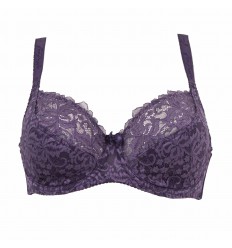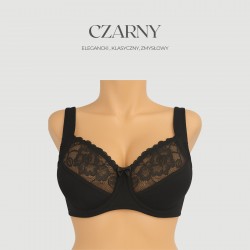- today
- perm_identity Anfen
- label News
- favorite 0 likes
- remove_red_eye 133 views
- comment 0 comments

Underwear sizing is something that can be difficult not only for female customers, but also for lingerie shop entrepreneurs. Although manufacturers often provide size charts, in practice the differences between brands and cuts can sometimes be significant. For a retailer, understanding what bra sizes are, as well as the sizes of women's panties that are popular, is the basis of a well-planned range.
In our article, you'll find key information that will help you optimise your orders and minimise the number of returns or exchanges, and make it easier for you to serve your customers. Use our tips and adapt them to your business to grow it in line with your goals.
What are bra sizes and how do you help customers choose them?
Bras have markings that many female customers do not understand. As a retailer, you are surely aware that they consist of a number that indicates the circumference under the bust and a letter that indicates the cup size. These two parameters are dependent on each other, so a well-fitting bra is one in which both are perfectly matched to the figure. Since customers often do not know how to choose their bra size when they have a lingerie shop, it is worth providing support in this aspect. A professional brafitting service, or bra sizing, is an added value that can make your salon perceived as a premium shop.
The most commonly sold sizes, and the most popular parameter configurations, are 75B, 75C, 80B, 80C and 85B. These are the sizes most often chosen in Poland. However, it's worth offering other, rarer sizes too, such as 65D or 90F, especially if you plan to attract female customers who have less standard sizes and are looking for a better fit than before. Once you've attracted such shoppers and offered them the quality they're after, you'll gain a loyal clientele who will keep coming back to you.
How does bra size vary between manufacturers?
It's worth knowing that bra size can vary depending on the brand, country of origin or cut. A push-up bra has a different construction than a classic balconette, which affects the size fit. If you offer products from different brands, make sure there is a clear size chart in the description. Ideally, it should include under bust and bust measurements, not just the final symbol. This will make it easier for customers to size bras themselves.
Unfortunately, customers often make the wrong bra size choice. For example, they decide on a model that is too loose in the circumference and too small in the cup. If your salespeople know the basics of brafitting, this will, as we have already mentioned, be a great asset to your shop. This will enable them to help shoppers make the right choice when they visit your showroom. As an added benefit, they will also be educated on what bra sizes are suitable for them for the future. As a result, customers will be able to make better purchasing decisions themselves and, satisfied with the comprehensive service, will be happy to return to your shop.
Women's panty sizes - demand and selection support
Pantysizes are indicated in a letter system: XS, S, M, L, XL, XXL and so on - or sometimes by their corresponding numerical designations, i.e. respectively: 34, 36, 38, 40, 42, 44 and so on. In Poland, sizes M and L are the most popular, but sizes S and XL also have very stable sales. There is also a growing demand for larger sizes such as XXL or 3XL, especially if you offer seamless or modelling underwear. It is worth considering whether you want to have a plus size range in your shop, as women who choose these sizes tend to become loyal customers. They won't get their size of women's panties in every store, so by hitting on fitted and quality lingerie, they are often happy to buy again in the same place.
Panty sizes can vary slightly between manufacturers, so it is useful to include both a letter or number symbol and a range of measurements in the hips in the description of a particular model. In this way, the customer will be able to better select the underwear to suit her figure. Of course, not every woman knows her measurements by heart, so in a stationary shop it is a good idea to support customers in their shopping choices. Just as it's a good idea to help with bra sizing, you can empathetically suggest the best-fitting women's panty sizes.
Women's panty sizes - a guide table
Below you will find a simple table to help you work out the most commonly purchased sizes of panties. It's worth using as a starting point if you don't already have much of your own sales data for your shop. Once you have been operating in the market for a while, you will see for yourself how demand for particular sizes of women's panties is shaping up at your store. The table can then be modified to suit your own needs.
| Size | Hip circumference (cm) | Estimated share of sales |
|---|---|---|
| XS | 84-88 | 8% |
| S | 88-92 | 18% |
| M | 92-96 | 30% |
| L | 96-100 | 25% |
| XL | 100-106 | 12% |
| XXL | 106-112 | 5% |
| 3XL | 112-118 | 2% |
These proportions may vary depending on the profile of your shop, its target group and the type of lingerie you offer. If you specialise in basic models, sizes M and L will dominate. On the other hand, if you have an extensive plus size lingerie offer, the proportion of sizes above XL will be significantly higher.
What are the most common sizing mistakes?
With both bras and panties, customers often buy 'by eye'. They are guided by previous purchases rather than their actual measurements. If you run a shop, you can reduce returns and complaints if you provide clear descriptions and size charts, and make an active effort to help shoppers.
Whether you have a stationary shop or sell online, it is worth educating your customers: reminding them how to measure their bust and under bust circumference, how to choose the right cut for their figure and how to check whether the panties are too small or too loose. A simple informative resource or a tab like How to size women's panties? on a website can make a big difference.
How do I size ratio when ordering in bulk?
When ordering for a shop, you need to estimate which sizes will sell best. A universal rule of thumb is as follows:
- order the most pieces in sizes M and L (these should make up about 50-55% of the order),
- on average 15-20% of your order should be sizes S and XL,
- buy approx. 10% of the XS and XXL sizes,
- it's worth having single pieces of 3XL and larger on offer, but not in large quantities - unless you specialise in this category.
When it comes to bras, it's worth choosing popular circumferences (75, 80, 85) and medium cups (B, C), but not giving up on larger ones(D, E). This is especially important in plus size and sports models. However, it is worth mentioning that these rules apply to shops that do not specialise in any particular category. The table presented in the article with the sizes of women's panties that are most commonly chosen is not everything. Always adapt the guidelines in terms of the profile of your salon or boutique, as depending on it, the proportions of panty or bra sizes in your order may vary significantly.
Equipping your shop with full sizing is not enough!
Knowing the demand for specific sizes of women's panties and bras is a key part of your lingerie shop's buying strategy. The better you understand your customers' needs, the more accurately you can compose your offer. The right size ratio, clear descriptions and education are not only a guarantee of higher sales, but also greater customer satisfaction. A satisfied shopper is more likely to come back to you to make another order and, in addition, may recommend your shop to her friends. It is therefore worth providing a comprehensive service, rather than just ensuring that your showroom is equipped and your merchandise is properly displayed.



Comments (0)